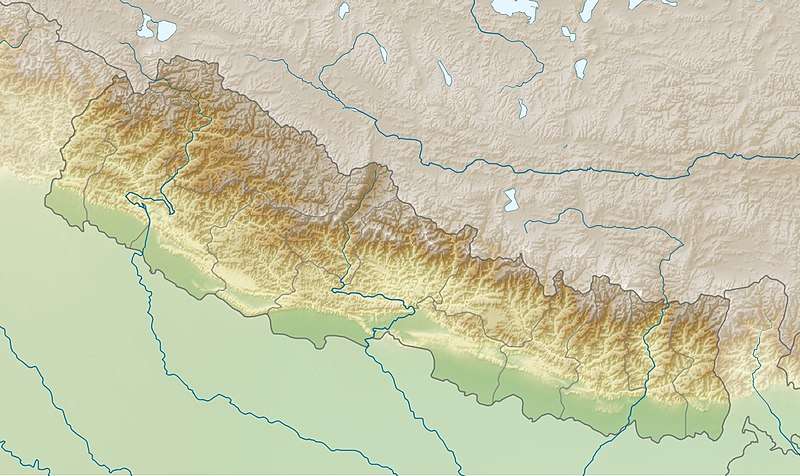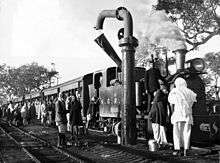Nepal Government Railway
The Nepal Government Railway (NGR) was Nepal's first railway in Nepal. Established in 1927 and closed in 1965, it linked Amlekhganj with Raxaul across the border in India in the south. The 2 ft 6 in (762 mm) narrow gauge railway was 47 km long.[1][2]
| Industry | Rail transport |
|---|---|
| Successor | Nepal Railways Corporation Ltd |
| Founded | 1927 |
| Founder | Jang Bahadur Rana with association of British Indian Government |
| Defunct | 1965 |
Area served | Nepal |

History

In 1923, a short narrow gauge railway was built by J. V. Collier of the Indian Forest Service to transport Nepalese timber to India. Collier had been assigned by Nepal's Rana prime minister to manage the forest department in Nepal. In the winter of 1924, Martin and Co. of Kolkata conducted a survey to construct a light railway from the border north to Bichako (Amlekhganj).[3]
Construction began in March 1926, and the Nepal Government Railway opened on 16 February 1927.[4] The narrow gauge railway used a track gauge of 2 ft 6 in (762 mm). The railway possessed seven steam locomotives, 12 coaches and 82 wagons.[5] It operated steam-powered Garratt locomotives manufactured by Beyer, Peacock and Company of the United Kingdom.[6]
Until the highway was built, the Amlekhganj-Raxaul railway was the only route indirectly connecting the capital Kathmandu with India. From Kathmandu, travellers journeyed over the hills on foot, and then by lorry to Amlekhganj where they took the train to India.[7] The need to walk was eliminated after Tribhuvan Highway linking Kathmandu with Amlekhganj was built in 1956. The first daily bus service began operating on it in 1959, conducted by a private company named Nepal Transport Service.[8][9]
Closure
The Nepal Government Railway remained in service till 1965 when the construction of the highway linking the southern border made it redundant.[10] The railway was closed down 1965 subsequently.
In popular culture
The Nepal Government Railway appears in the opening scenes of the first Nepali film Aama ("Mother") made by the government of Nepal and released in 1964. It shows the hero, a Gurkha soldier returning to Nepal on leave, travelling on the train as he heads for home.
Gallery
 Nepal Government Railway in 1927.
Nepal Government Railway in 1927. NGR locomotive No. 4, ca 1932.
NGR locomotive No. 4, ca 1932. NGR locomotive, ca 1947.
NGR locomotive, ca 1947. NGR at Raxaul station in 1951.
NGR at Raxaul station in 1951. Train ticket Raxaul-Simra
Train ticket Raxaul-Simra
See also
References
- United States Department of Commerce, Bureau of Foreign and Domestic Commerce (1927). Commerce Reports Nos.14-26. Volume 2. p. 148. Retrieved 26 July 2013.
- Tilman, H.W. (1952). Nepal Himalaya (PDF). p. 9. Retrieved 26 July 2013.
- Landon, Perceval (1928). Nepal. London: Constable and Co. Ltd. pp. 197, 201. Retrieved 20 September 2013.
- Aitchison, Sir Charles Umpherston (1929). A Collection of Treaties, Engagements and Sanads Relating to India and Neighbouring Countries, Volume 14. Government of India Central Publication Branch. p. 47. Retrieved 29 July 2013.
- "Railroads". A Country Study: Nepal. The Library of Congress. 22 March 2011. Retrieved 26 July 2013.
- "Garratt Locomotives produced by Beyer Peacock". Retrieved 29 July 2013.
- "Nepal 1954". Archived from the original on 21 October 2013. Retrieved 26 July 2013.
- Tuladhar, Kamal Ratna (26 September 2008). "Nepal took the bus half a century ago". The Kathmandu Post. Archived from the original on 24 October 2013. Retrieved 27 July 2013.
- Shrestha, Surya Bahadur. "Railway Development In Nepal". The Rising Nepal. Archived from the original on 4 December 2010. Retrieved 27 July 2013.
- A National Transport System for Nepal (PDF). Washington, D.C.: World Bank. June 1965. p. 22. Retrieved 25 May 2014.